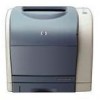HP 2500 HP PCL/PJL reference - Printer Job Language Technical Reference Manual - Page 214
Programming Tips for Using PJL, interface or the MIO interface.
 |
View all HP 2500 manuals
Add to My Manuals
Save this manual to your list of manuals |
Page 214 highlights
printer's response. The simplest solution for printer sharing boxes is to forward all data received from the printer to all attached host computers, and let the applications on each host computer ignore any impertinent data, as described in the "Handling Unexpected Printer Responses" section in this chapter. The printer in this example is also attached directly to a network via a network interface card installed into the printer's MIO interface. Network servers #4 and #5 spool print jobs from network clients #6 and #7. In this example, the network clients can not interact directly with the network-attached printer. The network spoolers can inject a "print job" to query the printer and can expect to get responses back. However, for this example, the network operating system does not provide a mechanism which allows applications running on a network client to query the printer and get a response. The printer's I/O card, the printer sharing box, and the spoolers running on the network servers can query the printer and expect to receive a response since those components are connected directly to the printer (i.e., no other printing system component except for the communication cable is between the printer and those components). In summary, an application running on host computer #1 can receive printer responses if the operating system on the host computer supports bi-directional communication over the serial I/O interface. The application may have to wait for the printer's response if the printer is processing a job from either the IEEE-1284-compatible I/O interface or the MIO interface. An application running on host computer #2 or #3 may receive printer responses if the printer sharing box supports bi-directional printer communication. However, since the printer sharing box does not have enough information to route the response to the correct host computer, the printer sharing box can forward all printer responses to all attached host computers and let the application on the host computer ignore any unneeded printer responses. Applications on network clients #6 and #7 cannot receive any printer responses due to the underlying network operating system. However, the printer sharing box, the I/O card installed in the printer, and spoolers running on network servers #4 and #5 can all query the printer and expect a printer response (although the response will not be immediate if the printer is processing a print job from a different I/O interface). 11-20 Programming Tips for Using PJL EN















